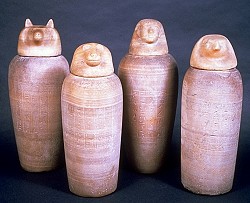
Bezeichnung für die Krüge und Kästen, die die mumifizierten inneren Organe enthielten. Die Krüge haben gewöhnlich Deckel in Gestalt der Köpfe der vier Horuskinder: Amset, Hepi, Duamutef und Kebehsenuef. Diese Götter beschützten die inneren Organe (Leber, Magen, Lungen und Darm) und wurden wiederum von vier Göttinnen (Isis, Neith, Nephthys und Selqet) beschützt, die auch mit den vier Haupthimmelsrichtungen (Süden, Osten, Norden und Westen) verbunden wurden. Die Erhaltung der inneren Organe bei der Mumifizierung ist erstmals im Fall der Königin Hetepheres, der Frau des Snofru und Mutter des Cheops belegt. In ihrem Grab wurde ein vierfach unterteilter Kasten aus Travertin (Ägyptischer Alabaster) gefunden. Drei dieser Fächer enthielten Überreste ihrer in Natron aufbewahrten inneren Organe; im vierten fand man getrocknetes organisches Material. Das Wort 'Kanope' leitet sich vom Namen des griechischen Seefahrers Kanopus her, der angeblich in Kanopus (Abuqir) im Delta begraben wurde und der in griechisch-römischer Zeit in Gestalt eines Kruges mit einem menschlichen Kopf verehrt wurde. Obwohl der 'Krug' in Kanopus die Gestalt des Gottes Osiris besaß und in keiner Beziehung zu den inneren Organen stand, ist der Name nichtsdestotrotz in den allgemeinen Sprachgebrauch übergegangen.